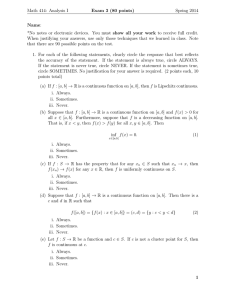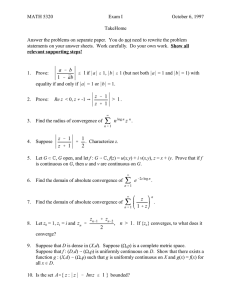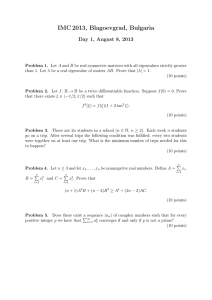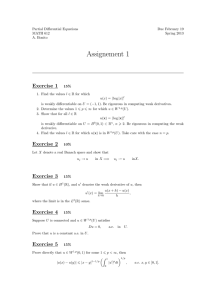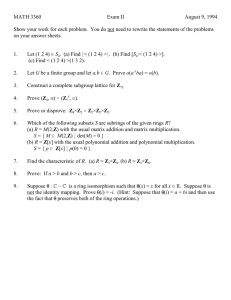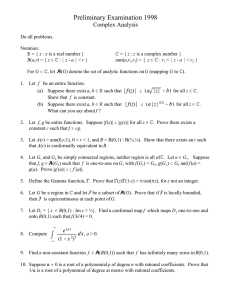Math 414: Analysis I Practice Exam 3 Spring 2014 Name:
advertisement
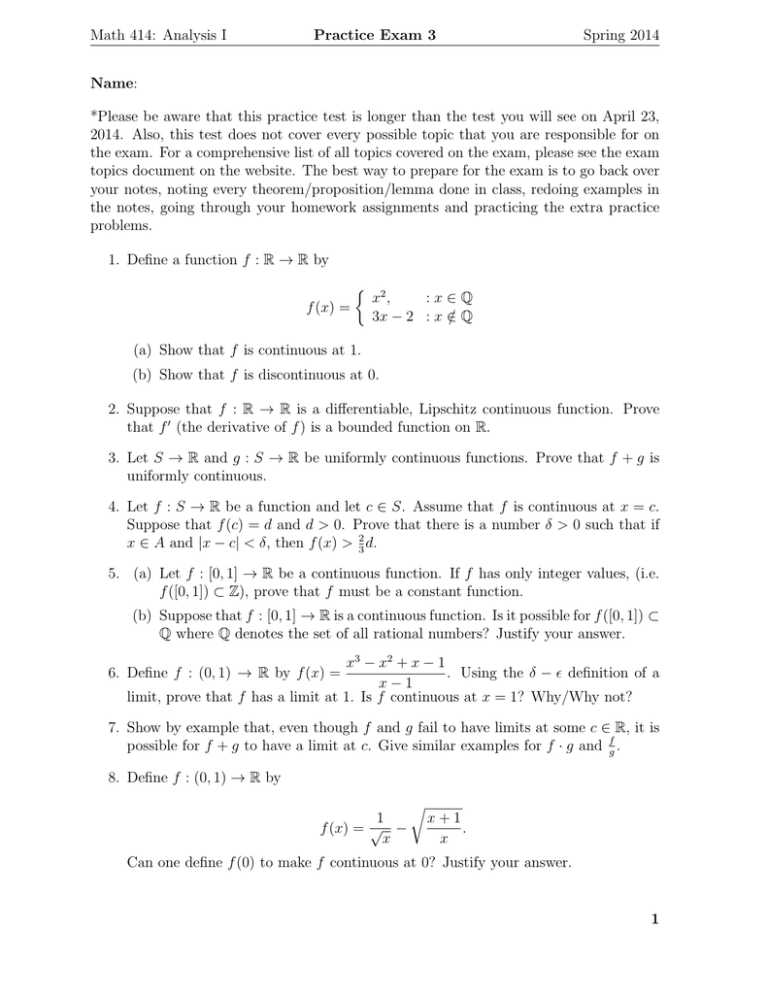
Math 414: Analysis I Practice Exam 3 Spring 2014 Name: *Please be aware that this practice test is longer than the test you will see on April 23, 2014. Also, this test does not cover every possible topic that you are responsible for on the exam. For a comprehensive list of all topics covered on the exam, please see the exam topics document on the website. The best way to prepare for the exam is to go back over your notes, noting every theorem/proposition/lemma done in class, redoing examples in the notes, going through your homework assignments and practicing the extra practice problems. 1. Define a function f : R → R by f (x) = x2 , :x∈Q 3x − 2 : x ∈ /Q (a) Show that f is continuous at 1. (b) Show that f is discontinuous at 0. 2. Suppose that f : R → R is a differentiable, Lipschitz continuous function. Prove that f 0 (the derivative of f ) is a bounded function on R. 3. Let S → R and g : S → R be uniformly continuous functions. Prove that f + g is uniformly continuous. 4. Let f : S → R be a function and let c ∈ S. Assume that f is continuous at x = c. Suppose that f (c) = d and d > 0. Prove that there is a number δ > 0 such that if x ∈ A and |x − c| < δ, then f (x) > 32 d. 5. (a) Let f : [0, 1] → R be a continuous function. If f has only integer values, (i.e. f ([0, 1]) ⊂ Z), prove that f must be a constant function. (b) Suppose that f : [0, 1] → R is a continuous function. Is it possible for f ([0, 1]) ⊂ Q where Q denotes the set of all rational numbers? Justify your answer. x3 − x2 + x − 1 6. Define f : (0, 1) → R by f (x) = . Using the δ − definition of a x−1 limit, prove that f has a limit at 1. Is f continuous at x = 1? Why/Why not? 7. Show by example that, even though f and g fail to have limits at some c ∈ R, it is possible for f + g to have a limit at c. Give similar examples for f · g and fg . 8. Define f : (0, 1) → R by 1 f (x) = √ − x r x+1 . x Can one define f (0) to make f continuous at 0? Justify your answer. 1 Math 414: Analysis I Practice Exam 3 Spring 2014 9. Suppose that √f : R → R is continuous and f (r) = r2 for all rational numbers r. Determine f ( 2) and justify your answer. 10. Let f : S → R be continuous at c ∈ R. Prove that there is a M > 0 and a δ > 0 such that |f (x)| ≤ M for all x ∈ (c − δ, c + δ) ∩ S. Hint: You must handle the cases where c is a cluster point and when c is not a cluster point separately. 11. Define h(x) = x3 sin x1 for x 6= 0 and h(0) = 0. Show that h is differentiable everywhere and that h0 is continuous everywhere but fails to have a derivative at one point. You may use the rules for differentiating products, sums, and quotients of elementary functions that you learned in calculus. 12. Suppose that f : (a, b) → R is differentiable at x ∈ (a, b). Prove that f (x + h) − f (x − h) h→0 2h lim exists and equals f 0 (x). Remark: It turns out that the converse of this statement is not true. Can you find an example that supports this claim? 13. Suppose that f : (a, b) → R is continuous on (a, b) and differentiable at c ∈ (a, b). Define f (x) − f (c) , x ∈ (a, b), x 6= c, x−c and g(c) = f 0 (c). Prove that g is continuous on (a, b). g(x) = 14. Let I = [a, b] and let f : I → R be a continuous function on I such that for each x in I there is a y ∈ I such that |f (y)| ≤ 21 |f (x)|. Prove that there is a point c ∈ I such that f (c) = 0. 15. Let f be continuous on the interval [0, 1] to R and suchthat f (0) = f (1). Prove that there is a point c in [0, 12 ] such that f (c) = f c + 12 . Hint: Consider g(x) = 1 f (x) − f x + 2 . 2


